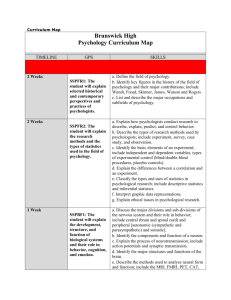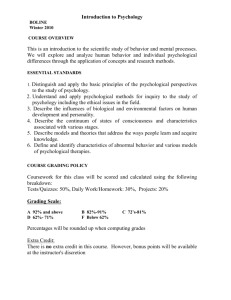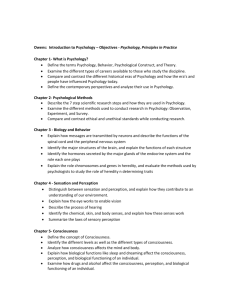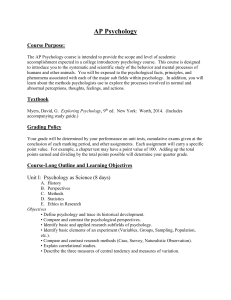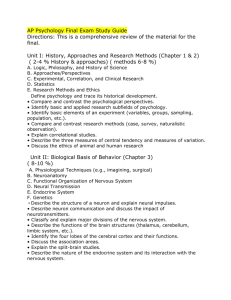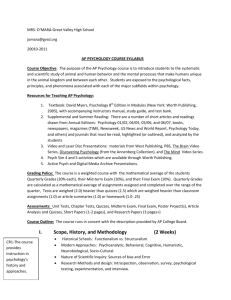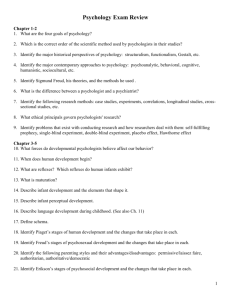Course Objectives
advertisement
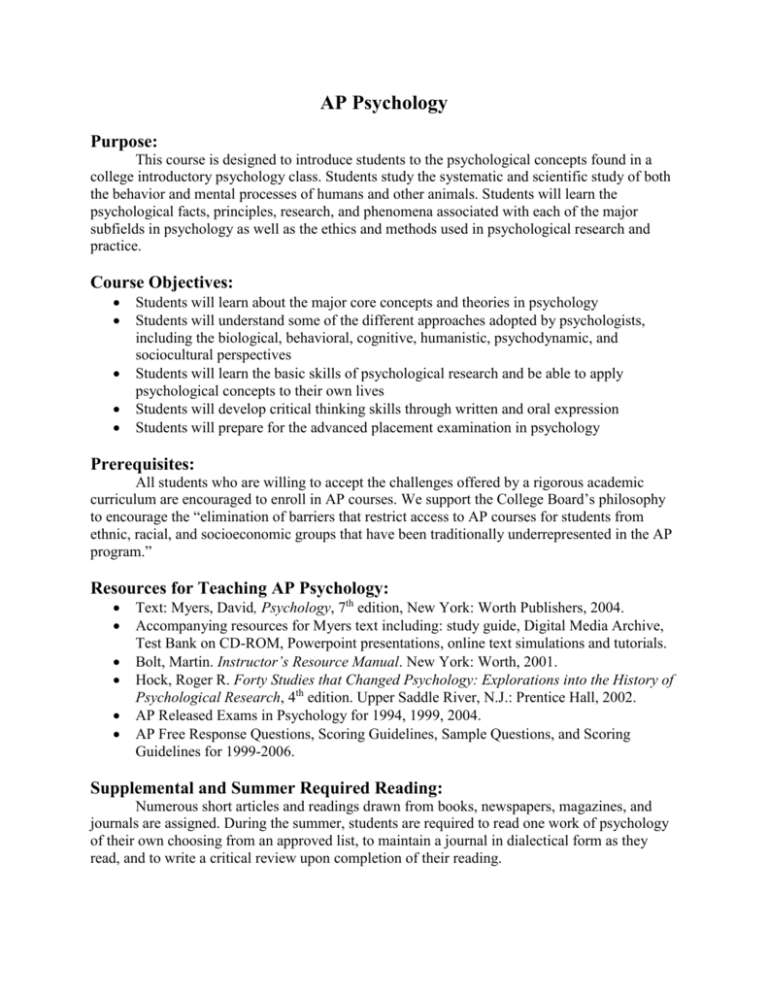
AP Psychology Purpose: This course is designed to introduce students to the psychological concepts found in a college introductory psychology class. Students study the systematic and scientific study of both the behavior and mental processes of humans and other animals. Students will learn the psychological facts, principles, research, and phenomena associated with each of the major subfields in psychology as well as the ethics and methods used in psychological research and practice. Course Objectives: Students will learn about the major core concepts and theories in psychology Students will understand some of the different approaches adopted by psychologists, including the biological, behavioral, cognitive, humanistic, psychodynamic, and sociocultural perspectives Students will learn the basic skills of psychological research and be able to apply psychological concepts to their own lives Students will develop critical thinking skills through written and oral expression Students will prepare for the advanced placement examination in psychology Prerequisites: All students who are willing to accept the challenges offered by a rigorous academic curriculum are encouraged to enroll in AP courses. We support the College Board’s philosophy to encourage the “elimination of barriers that restrict access to AP courses for students from ethnic, racial, and socioeconomic groups that have been traditionally underrepresented in the AP program.” Resources for Teaching AP Psychology: Text: Myers, David, Psychology, 7th edition, New York: Worth Publishers, 2004. Accompanying resources for Myers text including: study guide, Digital Media Archive, Test Bank on CD-ROM, Powerpoint presentations, online text simulations and tutorials. Bolt, Martin. Instructor’s Resource Manual. New York: Worth, 2001. Hock, Roger R. Forty Studies that Changed Psychology: Explorations into the History of Psychological Research, 4th edition. Upper Saddle River, N.J.: Prentice Hall, 2002. AP Released Exams in Psychology for 1994, 1999, 2004. AP Free Response Questions, Scoring Guidelines, Sample Questions, and Scoring Guidelines for 1999-2006. Supplemental and Summer Required Reading: Numerous short articles and readings drawn from books, newspapers, magazines, and journals are assigned. During the summer, students are required to read one work of psychology of their own choosing from an approved list, to maintain a journal in dialectical form as they read, and to write a critical review upon completion of their reading. Homework Expectations: Being a college level course, homework will be given every night. The amount of work depends on the unit being covered in class. Ample notice will be given prior to any assignment, quiz, or exam. Throughout the year students will be expected to do outside research and projects in addition to regular homework assignments. In the event of a missed class the student is responsible for any missed work. Vocabulary terms are also given for each unit. Quizzes are administered frequently, at least once a unit. The quizzes are in multiple formats. Exams will be given at the end of each unit and will consist of 45 multiple choice questions and one freeresponse question, simulating the AP exam. Grading Policy: Tests and major projects Quizzes Homework/Classwork 55% 25% 20% Course Outline: Unit 1: History, Approaches and Research Methods A. Logic, Philosophy, and History of Science B. Approaches/Perspectives C. Experimental, Correlation, and Clinical Research D. Statistics E. Research Methods and Ethics Objectives: Define psychology and trace its historical development Compare and contrast the psychological perspectives Identify basic and applied research subfields of psychology Identify basic elements of an experiment (variables, groups, sampling, population, etc.) Compare and contrast research methods (case, survey, naturalistic observation) Explain correlational studies Describe the three measures of central tendency and measures of variation Discuss the ethics of animal and human research Unit 2: Biological Basis of Behavior A. Physiological Techniques (e.g., imagining, surgical) B. Neuroanatomy C. Functional Organization of Nervous System D. Neural Transmission E. Endocrine System F. Genetics Objectives: Describe the structure of a neuron and explain neural impulses Describe neuron communication and discuss the impact of neurotransmitters Classify and explain major divisions of the nervous system Describe the functions of the brain structures (thalamus, cerebellum, limbic system, etc.) Identify the four lobes of the cerebral cortex and their functions Discuss the association areas Explain the split-brain studies Describe the nature of the endocrine system and its interaction with the nervous system Unit 3: Developmental Psychology A. Life-Span Approach B. Research Methods C. Heredity-Environment Issues D. Developmental Theories E. Dimensions of Development F. Sex Roles, Sex Differences Objectives: Discuss the course of prenatal development Illustrate development changes in physical, social, and cognitive areas Discuss the effect of body contact, familiarity, and responsive parenting on attachments Describe the benefits of a secure attachment and the impact of parental neglect and separation as well as day care on childhood development Describe the theories of Piaget, Erikson, and Kohlberg Describe the early development of a self-concept Distinguish between longitudinal and cross-sectional studies Unit 4: States of Consciousness A. Sleep and Dreaming B. Hypnosis C. Psychoactive Drug Effects Objectives: Describe the cyclical nature and possible functions of sleep Identify the major sleep disorders Discuss the content and possible functions of dreams Discuss hypnosis, noting the behavior of hypnotized people and claims regarding its uses Discuss the nature of drug dependence Chart names and effects of depressants, stimulants, and hallucinogenic drugs Compare differences between NREM and REM Describe the physiological and psychological effects of depressants, stimulants, and hallucinogens Unit 5: Sensation and Perception A. Thresholds B. Sensory Mechanisms C. Sensory Adaptation D. Attention E. Perceptual Processes Objectives: Contrast the processes of sensation and perception Distinguish between absolute and difference thresholds Label a diagram of the parts of the eye and ear Describe the operation of the sensory systems (five senses) Explain the Young-Helmholtz and opponent-process theories of color vision Explain the place and frequency theories of pitch perception Discuss Gestalt psychology’s contribution to our understanding of perception Discuss research on depth perception and cues Unit 6: Learning A. Classical Conditioning B. Operant Conditioning C. Cognitive Processes in Learning D. Biological Factors E. Social Learning (Observational Learning) Objectives: Describe the process of classical conditioning (Pavlov’s experiments) Explain the processes of acquisition, extinction, spontaneous recovery, generalization, and discrimination Describe the process of operant conditioning, including the procedure of shaping, as demonstrated by Skinner’s experiments Identify the different types of reinforcers and describe the schedules of reinforcement Discuss the importance of cognitive processes and biological predispositions in conditioning Discuss the effects of punishment on behavior Describe the process of observational learning (Bandura’s experiments) Unit 7: Memory A. Memory Objectives: Describe memory in terms of information processing, and distinguish among sensory memory, short-term memory, and long-term memory Distinguish between automatic and effortful processing Explain the encoding process (including imagery, organization, etc) Describe the capacity and duration of long-term memory Distinguish between implicit and explicit memory Describe the importance of retrieval cues Discuss the effects of interference and motivated forgetting on retrieval Describe the evidence for the constructive nature of memory Unit 8: Thinking and Language A. Language B. Thinking C. Problem Solving and Creativity Objectives: Describe the nature of concepts and the role of prototypes in concept formation Discuss how we use trial and error, algorithms, heuristics, and insight to solve problems Explain how the representativeness and availability heuristics influence our judgments Describe the structure of language (phonemes, morphemes, grammar) Identify language developmental stages (babbling, one word, etc) Explain how the nature-nurture debate is illustrated in the theories of language development Discuss Whorf’s linguistic relativity hypothesis Describe the research on animal cognition and communication Unit 9: Motivation and Emotion A. Biological Bases B. Theories of Motivation C. Hunger, Thirst, Sex and Pain D. Social Motives E. Theories of Emotion F. Stress Objectives: Define motivation and identify motivational theories Describe the physiological determinants of hunger Discuss psychological and cultural influences on hunger Define achievement motivation, including intrinsic and extrinsic motivation Identify the three theories of emotion (James-Lange, Cannon-Bard, Schachter-Singer) Describe the physiological changes that occur during emotional arousal Discuss the catharsis hypothesis Describe the biological response to stress Unit 10: Testing and Individual Differences A. Standardization and Norms B. Reliability and Validity C. Types of Tests D. Ethics and Standards in Testing E. Intelligence F. Heredity/Environment and Intelligence G. Human Diversity Objectives: Trace the origins of intelligence testing Describe the nature of intelligence Identify the factors associated with creativity Distinguish between aptitude and achievement tests Describe test standardization Distinguish between the reliability and validity of intelligence tests Describe the two extremes of the normal distribution of intelligence Discuss evidence for both genetic and environmental influences on intelligence Discuss whether intelligence tests are cultural biased Unit 11: Personality A. Personality Theories and Approaches B. Assessment Techniques C. Self-concept/Self-esteem D. Growth and Adjustment Objectives: Describe personality structure in terms of the interactions of the id, ego, and superego Explain how defense mechanisms protect the individual from anxiety Describe the contributions of the neo-Freudians Explain how personality inventories are used to assess traits Describe the humanistic perspective on personality in terms of Maslow’s focus on selfactualization and Rogers’ emphasis on people’s potential for growth Describe the impact of individualism and collectivism on self-identity Describe the social-cognitive perspective on personality Discuss the consequences of personal control, learned helplessness, and optimism Unit 12: Abnormal Psychology A. Definitions of Abnormality B. Theories of Psychopathology C. Diagnosis of Psychopathology D. Anxiety Disorders E. Somatoform Disorders F. Mood Disorders G. Schizophrenic Disorders H. Organic Disorders I. Personality Disorders J. Dissociative Disorders Objectives: Identify the criteria for judging whether behavior is psychologically disordered Describe the medical model of psychological disorders Describe the aims of DSM-IV, and discuss the potential dangers of diagnostic labels Describe the symptoms of generalized anxiety disorder, phobias, obsessive-compulsive disorder, and posttraumatic stress disorder Describe and explain the development of somatoform and mood disorders Describe the various symptoms and types of schizophrenia Describe the nature of organic and personality disorders Describe the characteristics and possible causes of dissociative disorders Unit 13: Treatment of Psychological Disorders A. Treatment Approaches B. Modes of Therapy (e.g., individual, group) C. Community and Preventive Approaches Objectives: Discuss the aims and methods of psychoanalysis Identify the basic characteristics of the humanistic therapies Identify the basic assumptions of behavior therapy Describe the assumptions and goals of the cognitive therapies Discuss the benefits of group therapy and family therapy Discuss the findings regarding the effectiveness of the psychotherapies Discuss the role of values and cultural differences in the therapeutic process Identify the common forms of drug therapy and the use of electroconvulsive therapy Unit 14: Social Psychology A. Group Dynamics B. Attribution Process C. Interpersonal Perception D. Conformity, Compliance, Obedience E. Attitudes and Attitude Change F. Organizational Behavior G. Aggression/Antisocial Behavior Objectives: Describe the importance of attribution in social behavior Explain the effect of role-playing on attitudes in terms of cognitive dissonance theory Discuss the results of Asch’s experiment on conformity Describe Milgram’s controversial experiments on obedience Discuss how group interaction can facilitate group polarization and groupthink Describe the social, emotional, and cognitive factors that contribute to the persistence of cultural, ethnic, and gender prejudice and discrimination Discuss the issues related to aggression and attraction Explain altruistic behavior in terms of social exchange theory and social norms
